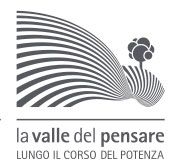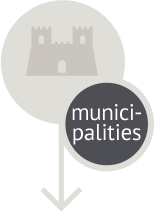Near the majestic “Piazza della Repubblica”, in XVIII century the “Filippini” (followers of San Filippo Neri) built a church dedicated to San Filippo Neri. The temple, built in 1766 and finished in 1773, it was erected in the same place where there was San Antonio Abate church, destroyed in 1366. Padre Carlo Fortunati was interested in the reconstruction and to make the building wider, he asked and obtained the use of a space of Piazza del Cassero.
The Lombard architect Carlo Augustoni projected the church, the oratory and the next monastery, while the architect Giovanni Antinori drew the façade. The temple was officiated from the 26th May 1778, on San Filippo Neri day, whom since 1626 was among the patrons of Montecchio.
The cardinal Grimaldi procured to the church the bodies of four Christian martyrs, died during the first persecutions: Aurelio, Valentino, Castoria, Venusta, which came from the catacombs and were put under the lateral altars.
At Congregazione’s expense were put in the recesses of walls, eight statues of the Roman sculptor Gioacchino Varlè, that represent the four evangelists and the four major Church Fathers.
Interesting also the painting of Prospero Mallarmino, that represents the Virgin in the first altar on the right.
In the second one on the left, there is the statue of Saint Patrick, patron of Treia and bishop of Iberna, in Manda. People say that the canons, when they were choosing the patron of the City, balloted Saint Patrick for three consecutive times.
The most important work of art in the church is a wooden Crucifix of XV century, that came from San Marco Church that represents “Il Cristo della pioggia”. The legend tells that the painter was a wanderer called Romeo, hosted by a family which lived in contrada San Marco.
The next “Casa Filippina” was expropriated first by the followers of “Napoleone”, then by the Unitarian States and turn as an office.
WOODEN CRUCIFIX - Painter of The Marche, in the second half of XV century
INSCRIPTION: INRI.
ICONOGRAPHY: on the cross is painted “Cristo patients”, on which face there is a thick beard and plentiful hair, wetted by rivulet blood that gush from the crown of thorns in the head. At the extremity of vertical altarpiece there is a pelican that feeds his sons and under the nest, twisted in the tree of the Cross, there is a snake. Tempera, cm 240 x 163.
The few known news, orally transmitted, remind the origin of the crucifix of Saint Marco church that, after being destroyed in XVII century, was relocated in San Filippo church.
The image very venerated and considered miraculous, as the major part of some popular icons and in the religious context of a certain period (as the sculpture production), proceeded in procession periodically the streets of the City, in order invoke the rain.
CURIOSITY
The devotion to Saint Filippo is arrived early to Treia, that since 1626 among the patrons of Montecchio there was the saint. It was a desire of everybody to have in Treia “I preti dell’oratorio” whom were diffused in the near villages. The fold of “oratorio di San Filippo Neri” was formed in 1631. The new church was built with the agreement of the archbishop of Camerino, (whose diocese included Treia), Cardinal Emilio Altieri, elected pope Clemente X (1670-1676)
THE MARTYRS
In the cavity of lateral altars there are the bodies of four saint martyrs, died during the first persecutions:Aurelio, Valentino, Castoria, Venusta.
THE EVANGELISTS
At Congregazione’s expense were put in the recesses of walls, eight statues that represent the four evangelists and the four major Church Fathers of the Roman sculptor Gioacchino Varlè, very admire from experts.
THE INDULGENCES
The church had the privilege of particular indulgences from 1728 for aggregation to the “Arcibasilica lateranense”.







